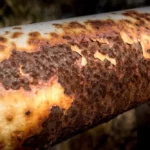Physical Properties of Aluminium:
| Appearance | Silvery-white solid. |
| Relative density | 2.7g/cm3. |
| Boiling point | 1484°C. |
| Melting point | 660oC. |
| Hardness | Relatively soft metal. |
| Ductility | It is ductile. It can be beaten into extremely thin sheets. It can therefore be rolled into a foil. |
| Malleability | It is malleable. Capable of being shaped or bent. |
| Conductivity | Good conductor of heat and electricity. |
| Crystalline structure | Cubic. |
| Tensile Strength | Moderate tensile strength but is high in its alloys. |
Chemical Properties of Aluminium
The chemical properties of aluminium include the following:
1. Reaction with Air:
When exposed to air, aluminium reacts with oxygen to form aluminium oxide, Al2O3.
At ordinary temperature and pressure, this oxide appears as a thin coat on the surface of the aluminium, which prevents further reaction with atmospheric oxygen, water or steam, under normal conditions. Therefore, this is the reason aluminium is said to be free of corrosion Corrosion is defined as a natural process that causes the transformation of pure metals into undesirable substances when they react with substances like water or air. This reaction causes damage and... More.
Corrosion is defined as a natural process that causes the transformation of pure metals into undesirable substances when they react with substances like water or air. This reaction causes damage and... More.
However, if the temperature is increased to 800oC and above, the remaining aluminium would react with oxygen and nitrogen of the air to form aluminium oxide, Al2O3 and nitride, AlN respectively.
4Al(s) + 3O2(g) → 2Al2O3(s)
2Al(s) + N2(g) → 2AlN(s)
2. Reaction with Non-Metals:
Heated Aluminium combines with a number of non-metals, such as halogens, sulphur, nitrogen, phosphorus and carbon, with the liberation of heat.
For example, 2Al(s) + 3Cl2(g) → 2AlCl3(s)
3. Reaction with Acids:
Aluminium reacts slowly with dilute HCl, but more rapidly with conc. HCL, displacing hydrogen
2Al(s) + 6HCl(aq) → 2AlCl3(aq) + 3H2(g)
Hot concentration of H2SO4 oxidizes aluminium to release sulphur(IV) oxide, SO2.
2Al(s) + 6H2SO4(aq) → Al2(SO4)3(aq) + 6H2O(l) + 3SO2(g)
Aluminium does not react with trioxonitrate(V) acid, HNO3 in both dilute and concentrated conditions. This is due to the formation of a protective thin layer of aluminium oxide on its surface. Hence, aluminium containers are commonly used in transporting HNO3.
4. Reaction With Alkalis:
In alkalis such as sodium hydroxide or potassium hydroxide, aluminium dissolves to form a complex salt, with the release of hydrogen.
For example,
2Al(s) + 2NaOH(aq) + 6H2O(l) → 2NaAl(OH)4(aq) + 3H2(g)
Sodium aluminate, 2NaAl(OH)4 is a complex salt.
Washing soda is never used to clean aluminium articles. The reason is that aluminium is atmospheric. Being atmospheric it reacts with both acids (except HNO3) and alkalis to form salts.



Responses